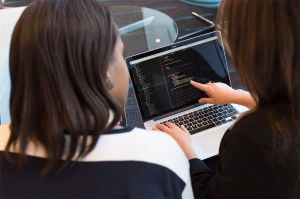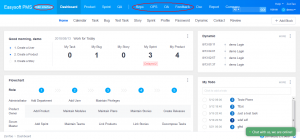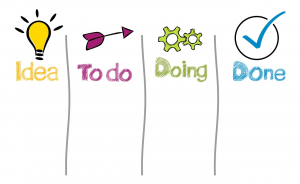How Collaborative Coding Works and How to Set It Up
- 2024-03-09 10:00:00
- Gregory Batchelor
- Original 642
There are some stereotypes when people think about programmers. They usually picture someone dressed in a hoodie and jeans, sitting alone in some gloomy basement room, slouching over a laptop, quaffing cups of coffee, and hammering away at their keyboard. Maybe some of those stereotypes were justified… 30 years ago.
The world of programming has changed a lot. Nowadays, developers don’t work alone anymore. They expect to be part of a bigger team. It makes sense – programs have gotten more complicated, customers more demanding.
Bigger teams mean that cooperation is more important than ever. Collaborative coding is a great way to achieve this. Keep reading to learn more about it.
What is collaborative coding?
Image Source: Pexels
Collaborative coding is an approach to programming where multiple programmers work together on the same code, combining their skills and perspectives to enhance the software development process. The idea is that everybody has different skills, so different developers will fill in the gaps in each other’s knowledge and spot each other’s mistakes. There are a few common ways to work together:
-
Pair Programming
This is where two developers share one workstation, with one designated as "the driver," writing the code, while the other ("the navigator") reviews the code and guides the process.
-
Mob Programming
An extension of pair programming, this involves a larger team, with one driver and multiple navigators, fostering a collective coding environment.
-
Code Swapping
Here, developers independently work on different code segments and then swap their work to help each other out, offering fresh ideas to work around problems and spot any errors their partner might have missed.
These practices have some significant benefits. For starters, it's incredible how often a fresh pair of eyes will spot the errors in your code that you can’t see after staring at it for several hours straight. Likewise, it can be just as challenging to work around a problem when you’re too engrossed in the details. Even better, whenever someone offers up a new solution or way of doing something, you learn from them, and you’ll be a better developer next time. They might even learn something from you, too. There’s no guarantee, of course, but you never know!
Of course, that’s not to say there aren’t difficulties when setting up collaborative teams. Still, for every challenge, there are solutions. From project management software like ZenTao to keeping teams organized and log forwarders, to keeping them connected to version control systems like Github, many technologies can help.
Image Source: ZenTao
How to Set Up Collaborative Coding Teams?
There are several things to keep in mind if you want your coding team to work efficiently.
1. Selecting the Right Team Members
The key to a successful collaborative coding team lies in choosing the right people. You’ll want to focus on getting the best blend of skills and experience, trying to pick people who can counterbalance each other – someone older with a lot of experience and someone younger who may have a different way of doing things.
This cross-functional collaboration can bring fresh ideas and innovative approaches to problem-solving, ultimately enhancing the quality of your code and fostering a more dynamic working environment.
2. Defining Roles and Responsibilities
Once you’ve set up your teams, everyone needs to know their role, especially when pair or mob coding. Clearly defining who the ‘driver’ and the ‘navigator’ are and ensuring everyone understands the scope of their role in this arrangement is critical. After a while, it’s important to switch roles so everybody can practice different skills.
Project management software that can act as a central place to organize your teams can be invaluable, especially as it means everyone knows where to access the information they need when undergoing projects. With remote access solutions like RealVNC, you can ensure that data is always accessed securely.
3. Training
Because collaborative coding may be a new way of working, consider setting up training sessions to get everyone orientated to their new roles. Creating a learning culture at work can help to bring your team together, and an orientation session can be an opportunity to make sure that everyone knows what they are expected to do and, crucially, why.
Be prepared for some resistance when changing working habits this way. More experienced developers may be especially put out. Introducing new methodologies can feel like an attack on the way they have been doing things. Alternatively, they may feel like they are being pushed into a teaching role when all they want to do is get on with their work.
For less experienced team members, there are risks, too; they may feel like they aren’t trusted. However, with appropriate training and orientation, many of these problems can be addressed and overcome before the practice is introduced. This training should also be extended to onboarding new hires to ensure they quickly become productive and integrated members of the collaborative coding team.
4. Security
Another consideration that you should be conscious of when setting up collaborative coding teams is security and keeping your data safe from cyber threats. Any change in the way people work is bound to take some adjusting to and could lead to errors being missed while teams adjust, especially as collaborative coding teams often implement regular updates and code changes, particularly if using Agile methodologies.
Putting extra checks in place is a sensible precaution, especially with development teams now so often working on live products, where something as simple as an SPF validation error could lead to security breaches.
5. Developing a Workflow
Image Source: Pixabay
The success of collaborative coding depends on setting up a well-defined workflow. You’ll need to establish roles and then set up routines. Clear protocols for code reviews, updates, and integration help everyone know what they’re doing.
Regularly scheduled reviews will also ensure that the code aligns with your project goals. Sticking to Continuous Integration Continuous Deployment (CI/CD) practices can also really help here, making sure that your whole team stays on track.
Also, consider removing distractions from your development team’s workflow when collaborative coding, as the entire team needs to work in unison for it to work properly. The key to this is organization and communication. For example, teams may get together and decide to dedicate a part of the week or day to complete concentration on the latest goal or problem.
Consider integrating a website builder tool into your workflow to streamline the process of creating and updating web-based components. This can be especially useful if your collaborative coding projects involve web development tasks
6. Communication Channels
Finally, take some time to ensure that you have set up proper communication channels for both individuals on the same team and between different collaborative groups. Without effective communication within teams, they will fall apart.
Set up regular meetings and use collaborative tools, such as messaging services, to aid communication between your teams and ensure that everyone is on the same page. Finally, a call center service solution could help keep your teams connected with your customers to get the feedback they need to keep improving your software.
Final thoughts
Collaborative coding can lead to quicker problem-solving, higher-quality code, and better-performing software. Of course, there are undoubtedly challenges to overcome when setting up collaborative coding teams.
Still, with proper planning and training, these difficulties can be overcome. In a competitive field such as software development, striving for every advantage you can get is essential, and having teams that can work together synergistically could be the edge you need.
Products
- ZDOO
- ZDOO Cloud
Support
- Book a Demo
- Tech Forum
- GitHub
- SourceForge
About Us
- Company
- Privacy Policy
- Term of Use
- Blogs
- Partners
Contact Us
- Leave a Message
- Email Us: support@zentaoalm.com









